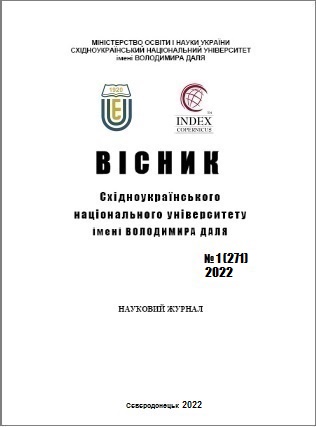Імітаційне моделювання асинхронного електродвигуна для підвищення рівня діагностичних систем
DOI:
https://doi.org/10.33216/1998-7927-2022-271-1-18-23Ключові слова:
імітаційне моделювання, асинхронний двигун, несиметрія обмоток, діагностика, обмотки статораАнотація
Враховуючи досить широку сферу застосування асинхронних двигунів та складні умови їх експлуатації з постійно зростаючою ціною відмови, стрімко зростають і вимоги до їх надійності, своєчасного визначення стану та часу безвідмовної роботи, що забезпечує надійну і непереривну роботу асинхронних двигунів. Для підвищення рівня надійності та непереривної роботи асинхронних електродвигунів необхідно проводити удосконалення вже існуючих та розробку нових методів їх діагностування, що відбувається шляхом проведення досліджень процесів при різних дефектах двигунів з використанням сучасних засобів, зокрема імітаційного моделювання, за допомогою котрого є можливість побудови моделі, що описують процеси так, як вони проходили б у дійсностіУ роботі проведено аналіз принципу запропонованої імітаційної моделі асинхронного електродвигуна та проведено порівняння одержаних результатів моделювання з розрахунковими даними за класичною методикою, яка приведена в роботі.Максимальна похибка при порівнянні параметрів знаходиться у межах 0,045–6,365 %, що підтверджує адекватність моделі та великий рівень точності імітаційної моделі для якої були проведені розрахунку. Крім того, модель що розглядається у роботі, дає можливість створювати несиметричне обертове поле статора для проведення подальших досліджень пошкоджень обмотки при міжвиткових замиканнях, що є дуже актуальним питанням при визначенні технічного стану двигуна.У використовуваній досліджуваній математичній моделі асинхронного двигуна передбачений алгоритм врахування зміни взаємної індуктивності обмоток від зміни комплексного опору однієї або декількох обмоток, таке удосконалення моделі дозволить суттєво збільшити уяву про динамічні процеси, які реально відбуваються у двигуні з несиметричними обмотками, а також забезпечити подальший розвиток проведення діагностичних заходів з виявленням ступеню пошкодження обмотки статору. Для проведення досліджень з більш широким колом можливих дефектів, що впливають на режими роботи двигунів слід використовувати математичну модель асинхронного двигуна з можливостю створення несиметричного обертаючогополя виконану в «загальмованих координатах»з врахуванням втрат в сталі та механічних втрат.
Посилання
1. Ciprian H. Wavelet Analysis and Park's Vector Based Condition Monitoring of Induction Machines. / H. Ciprian, L. Szabó // Juornal of Computer Science and Control Systems, Vol.4, No 2, 2011, pp 35 -38.
2. Губаревич О.В., Гулак С.О., Голубєва С.М. Комплексний підхід до діагностування асинхронних електродвигунів водного транспорту: Новітні технології. Збірник наукових праць Приватного вищого навчального закладу «Університет новітніх технологій». К.: ПВНЗ «Університет новітніх технологій», 2019. Випуск 2(9). C.48-61.
3. Губаревич О.В. Надійність і діагностика електрообладнання: Підручник / О.В. Губаревич. Сєвєродонецьк: вид-во СНУ ім. В. Даля, 2016. 248 с.
4. Губаревич О.В., Голубєва С.М. Аналіз методів діагностики технічного стану ізоляції асинхронних двигунів: Всеукраїнський науковий збірник «Наукові праці Донецького національного технічного університету». Серія «Електротехніка і енергетика» – Покровськ: Вид.: Державний вищий навчальний заклад «Донецький національний технічний університет», №1(21), 2019. С. 55-63.
5. Chioncel, C. P., Tirian, G. O., Gillich N., Raducha E.. Vector Control Structure of an Asynchronous Motor at Maximum Torque [Text] /C. P. Chioncel, G. O. Tirian, N. Gillich, E. Raducha//International Conference on Applied Sciences – 2015. P. 012005 – 012010.
6. Pakkiraian, B., Sukumar, G.D. A New Modified Artificial Neural Network Based MPPT Controller for the Improved Performance of an Asynchronous Motor Drive [Text]/B. Pakkiraian, G.D. Sukumar//Indian Journal of Science and Technology. 2016 – Vol. 9, Issue 45. – P. 1 10.
7. Guo, Z., Zhang, Q.-Wei. The Study on Mathematical Model and Simulation of Asynchronous Motor Considering Iron Loss [Text]/Z. Guo, Q.-Wei Zhang//Journal of Physics: Conf. Series 1060. 2018. P. 012085 – 012090.
8. Dementyev Y.N., Umurzakova A.D. The Engine Mechanical Coordinates Measuring In The Asynchronous Motor [Text]/Y. N. Dementyev, A. D. Umurzakova// MATEC Web of Conferences. 2014. P. 01027-01032.
9. Balara, D., et al. Neural networks application for mechanical parameters identification of asynchronous motor [Text]/ D. Balara, J. Timko, J. Zilkov, A. M. Le So//Neural Network World. 2017 Vol. 27, Issue 3. P. 259-270.
10. Ruan, J. Y., & Wang, S. M. (2015). Magnetizing curve estimation of induction motors in single-phase magnetization mode considering differential inductance effect. IEEE Transactions on Power Electronics, 31(1), 497-506.
11. Singh, A., Grant, B., DeFour, R., Sharma, C., & Bahadoorsingh, S. (2016). A review of induction motor fault modeling. Electric Power Systems Research, 133, 191-197.
12. Pustovetov, M. Yu. A mathematical model of the three-phase induction motor in three-phase stator reference frame describing electromagnetic and electromechanical processes. IEEE Conference 2016 Dynamics of Systems, Mechanisms and Machines. Omsk [online]. 2016, p. 1-5. Available from: https://doi.org/10.1109/Dynamics.2016.7819069.
13. Pustovetov, M. Yu. Approach to Computer Implementation of Mathematical Model of 3-Phase Induction Motor//IOP Conf. Series: Materials Science and Engineering [online]. 2018, 327(2), p. 022085. Available from: https://10.1088/1757-899X/327/2/022085.
14. Goolak, S., Gubarevych, О., Yermolenko, E, Slobodyanyuk, M, Gorobchenko, O. Development of mathematical model of induction motor for vehicles. Eastern-European Journal of Enterprise Technologies. 2020, 2/2 (104), pp.24-35. DOI: 10.15587/1729-4061.2020.199559.
15. Копылов И.П. Проектирование электрических машин: учебник для вузов. М.: Юрайт, 2019. 828 с.

